Mental Health Nursing: Case Study of Paranoid Personality Disorder
VerifiedAdded on 2023/06/12
|15
|4486
|295
Case Study
AI Summary
This case study provides a clinical formulation of a 60-year-old patient, Jim (pseudonym), diagnosed with paranoid personality disorder. The formulation includes presenting problems such as intellectual disability and agitation related to his money, predisposing factors like a disrupted childhood and bullying, precipitating factors such as heightened anxiety when others touch his money, perpetuating factors including social isolation and poor communication skills, and protecting factors like adherence to a daily routine. The analysis utilizes the DSM-V criteria to support the diagnosis and explores the interplay of psychological, biological, spiritual, and social domains in understanding and addressing the patient's condition. This document is available on Desklib, where students can find more solved assignments and past papers.

Running head: MENTAL HEALTH NURSING
Assessment in Mental Health Nursing- Case Study
Name of the Student
Name of the University
Author Note
Assessment in Mental Health Nursing- Case Study
Name of the Student
Name of the University
Author Note
Paraphrase This Document
Need a fresh take? Get an instant paraphrase of this document with our AI Paraphraser
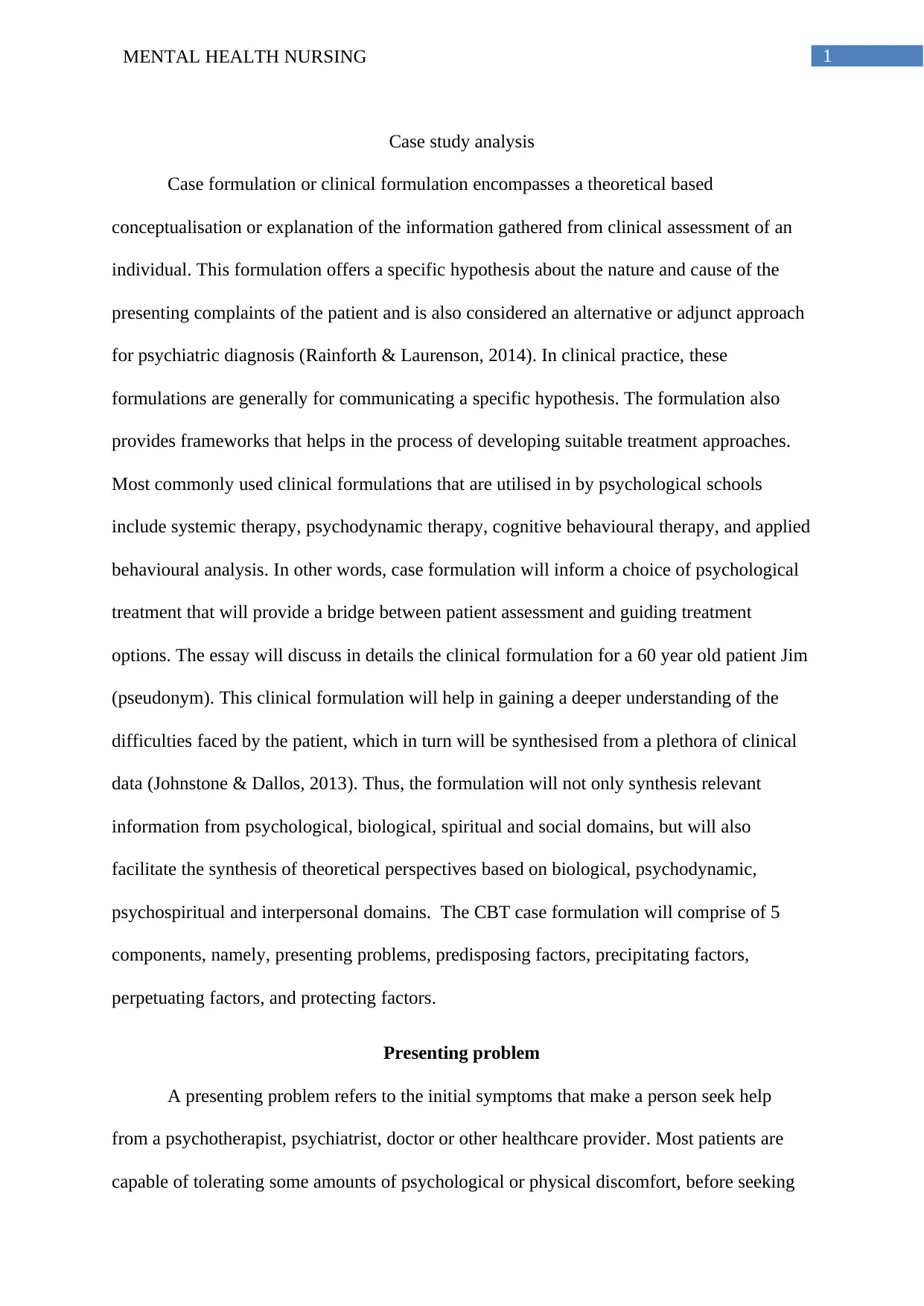
1MENTAL HEALTH NURSING
Case study analysis
Case formulation or clinical formulation encompasses a theoretical based
conceptualisation or explanation of the information gathered from clinical assessment of an
individual. This formulation offers a specific hypothesis about the nature and cause of the
presenting complaints of the patient and is also considered an alternative or adjunct approach
for psychiatric diagnosis (Rainforth & Laurenson, 2014). In clinical practice, these
formulations are generally for communicating a specific hypothesis. The formulation also
provides frameworks that helps in the process of developing suitable treatment approaches.
Most commonly used clinical formulations that are utilised in by psychological schools
include systemic therapy, psychodynamic therapy, cognitive behavioural therapy, and applied
behavioural analysis. In other words, case formulation will inform a choice of psychological
treatment that will provide a bridge between patient assessment and guiding treatment
options. The essay will discuss in details the clinical formulation for a 60 year old patient Jim
(pseudonym). This clinical formulation will help in gaining a deeper understanding of the
difficulties faced by the patient, which in turn will be synthesised from a plethora of clinical
data (Johnstone & Dallos, 2013). Thus, the formulation will not only synthesis relevant
information from psychological, biological, spiritual and social domains, but will also
facilitate the synthesis of theoretical perspectives based on biological, psychodynamic,
psychospiritual and interpersonal domains. The CBT case formulation will comprise of 5
components, namely, presenting problems, predisposing factors, precipitating factors,
perpetuating factors, and protecting factors.
Presenting problem
A presenting problem refers to the initial symptoms that make a person seek help
from a psychotherapist, psychiatrist, doctor or other healthcare provider. Most patients are
capable of tolerating some amounts of psychological or physical discomfort, before seeking
Case study analysis
Case formulation or clinical formulation encompasses a theoretical based
conceptualisation or explanation of the information gathered from clinical assessment of an
individual. This formulation offers a specific hypothesis about the nature and cause of the
presenting complaints of the patient and is also considered an alternative or adjunct approach
for psychiatric diagnosis (Rainforth & Laurenson, 2014). In clinical practice, these
formulations are generally for communicating a specific hypothesis. The formulation also
provides frameworks that helps in the process of developing suitable treatment approaches.
Most commonly used clinical formulations that are utilised in by psychological schools
include systemic therapy, psychodynamic therapy, cognitive behavioural therapy, and applied
behavioural analysis. In other words, case formulation will inform a choice of psychological
treatment that will provide a bridge between patient assessment and guiding treatment
options. The essay will discuss in details the clinical formulation for a 60 year old patient Jim
(pseudonym). This clinical formulation will help in gaining a deeper understanding of the
difficulties faced by the patient, which in turn will be synthesised from a plethora of clinical
data (Johnstone & Dallos, 2013). Thus, the formulation will not only synthesis relevant
information from psychological, biological, spiritual and social domains, but will also
facilitate the synthesis of theoretical perspectives based on biological, psychodynamic,
psychospiritual and interpersonal domains. The CBT case formulation will comprise of 5
components, namely, presenting problems, predisposing factors, precipitating factors,
perpetuating factors, and protecting factors.
Presenting problem
A presenting problem refers to the initial symptoms that make a person seek help
from a psychotherapist, psychiatrist, doctor or other healthcare provider. Most patients are
capable of tolerating some amounts of psychological or physical discomfort, before seeking
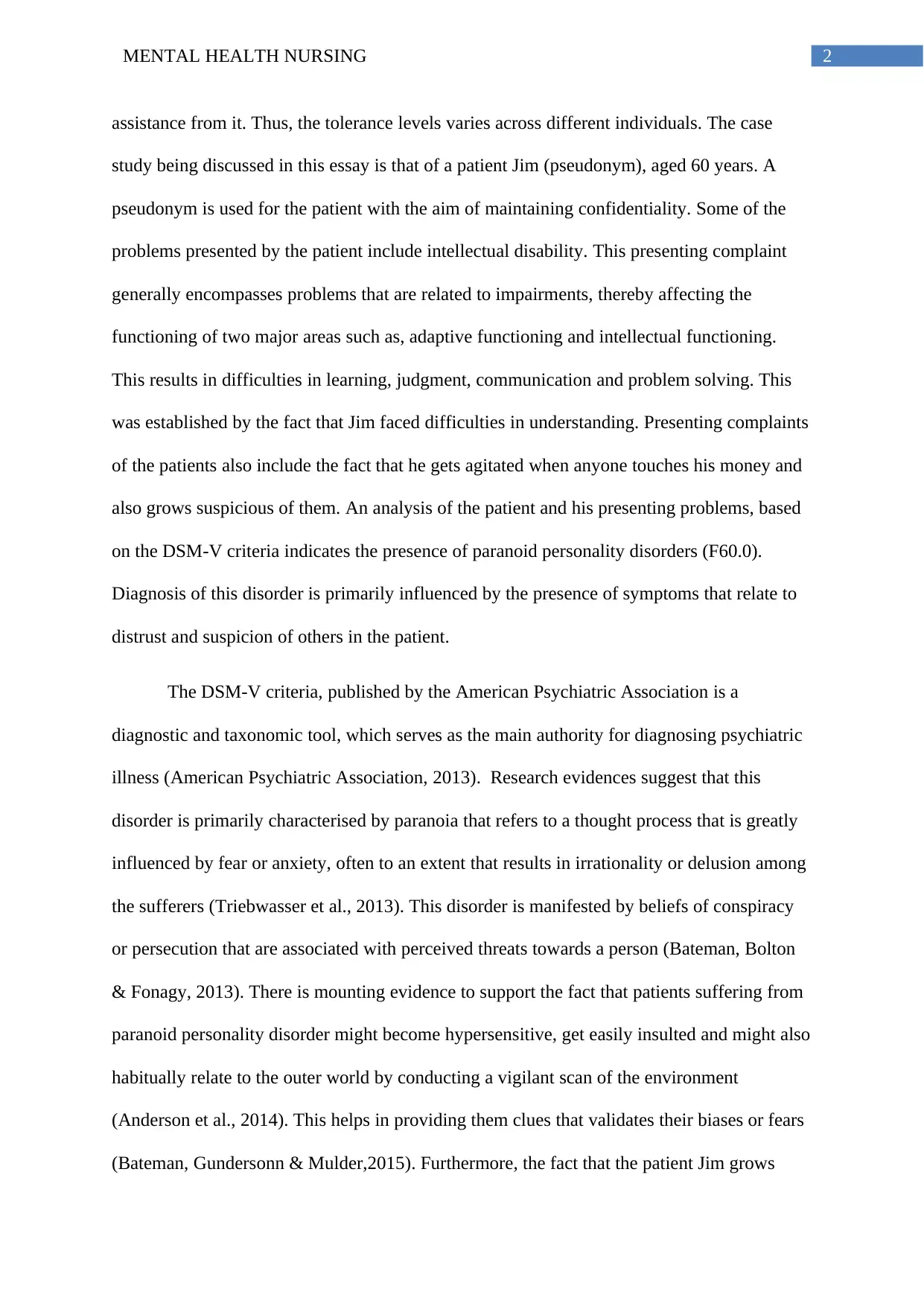
2MENTAL HEALTH NURSING
assistance from it. Thus, the tolerance levels varies across different individuals. The case
study being discussed in this essay is that of a patient Jim (pseudonym), aged 60 years. A
pseudonym is used for the patient with the aim of maintaining confidentiality. Some of the
problems presented by the patient include intellectual disability. This presenting complaint
generally encompasses problems that are related to impairments, thereby affecting the
functioning of two major areas such as, adaptive functioning and intellectual functioning.
This results in difficulties in learning, judgment, communication and problem solving. This
was established by the fact that Jim faced difficulties in understanding. Presenting complaints
of the patients also include the fact that he gets agitated when anyone touches his money and
also grows suspicious of them. An analysis of the patient and his presenting problems, based
on the DSM-V criteria indicates the presence of paranoid personality disorders (F60.0).
Diagnosis of this disorder is primarily influenced by the presence of symptoms that relate to
distrust and suspicion of others in the patient.
The DSM-V criteria, published by the American Psychiatric Association is a
diagnostic and taxonomic tool, which serves as the main authority for diagnosing psychiatric
illness (American Psychiatric Association, 2013). Research evidences suggest that this
disorder is primarily characterised by paranoia that refers to a thought process that is greatly
influenced by fear or anxiety, often to an extent that results in irrationality or delusion among
the sufferers (Triebwasser et al., 2013). This disorder is manifested by beliefs of conspiracy
or persecution that are associated with perceived threats towards a person (Bateman, Bolton
& Fonagy, 2013). There is mounting evidence to support the fact that patients suffering from
paranoid personality disorder might become hypersensitive, get easily insulted and might also
habitually relate to the outer world by conducting a vigilant scan of the environment
(Anderson et al., 2014). This helps in providing them clues that validates their biases or fears
(Bateman, Gundersonn & Mulder,2015). Furthermore, the fact that the patient Jim grows
assistance from it. Thus, the tolerance levels varies across different individuals. The case
study being discussed in this essay is that of a patient Jim (pseudonym), aged 60 years. A
pseudonym is used for the patient with the aim of maintaining confidentiality. Some of the
problems presented by the patient include intellectual disability. This presenting complaint
generally encompasses problems that are related to impairments, thereby affecting the
functioning of two major areas such as, adaptive functioning and intellectual functioning.
This results in difficulties in learning, judgment, communication and problem solving. This
was established by the fact that Jim faced difficulties in understanding. Presenting complaints
of the patients also include the fact that he gets agitated when anyone touches his money and
also grows suspicious of them. An analysis of the patient and his presenting problems, based
on the DSM-V criteria indicates the presence of paranoid personality disorders (F60.0).
Diagnosis of this disorder is primarily influenced by the presence of symptoms that relate to
distrust and suspicion of others in the patient.
The DSM-V criteria, published by the American Psychiatric Association is a
diagnostic and taxonomic tool, which serves as the main authority for diagnosing psychiatric
illness (American Psychiatric Association, 2013). Research evidences suggest that this
disorder is primarily characterised by paranoia that refers to a thought process that is greatly
influenced by fear or anxiety, often to an extent that results in irrationality or delusion among
the sufferers (Triebwasser et al., 2013). This disorder is manifested by beliefs of conspiracy
or persecution that are associated with perceived threats towards a person (Bateman, Bolton
& Fonagy, 2013). There is mounting evidence to support the fact that patients suffering from
paranoid personality disorder might become hypersensitive, get easily insulted and might also
habitually relate to the outer world by conducting a vigilant scan of the environment
(Anderson et al., 2014). This helps in providing them clues that validates their biases or fears
(Bateman, Gundersonn & Mulder,2015). Furthermore, the fact that the patient Jim grows
⊘ This is a preview!⊘
Do you want full access?
Subscribe today to unlock all pages.

Trusted by 1+ million students worldwide
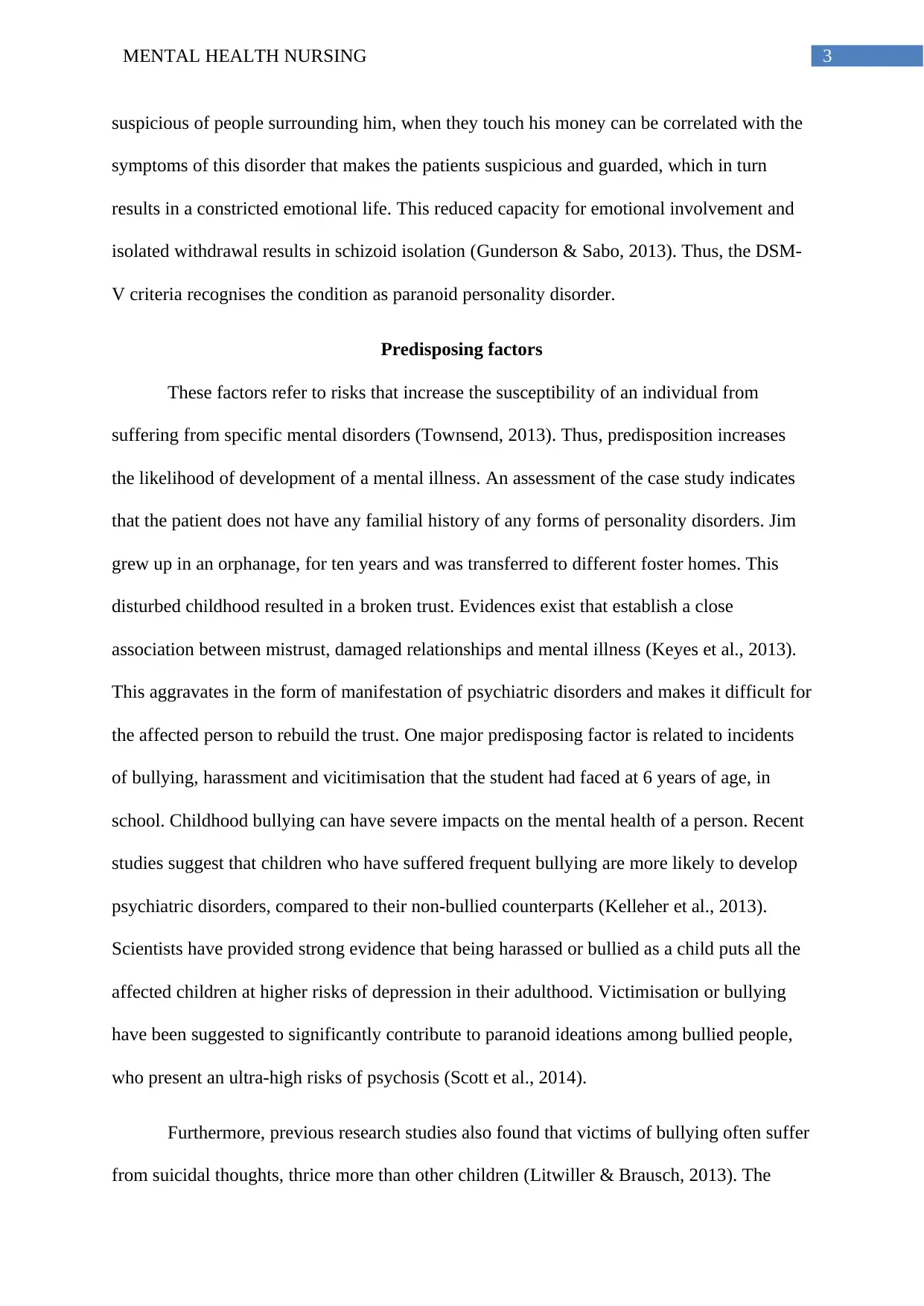
3MENTAL HEALTH NURSING
suspicious of people surrounding him, when they touch his money can be correlated with the
symptoms of this disorder that makes the patients suspicious and guarded, which in turn
results in a constricted emotional life. This reduced capacity for emotional involvement and
isolated withdrawal results in schizoid isolation (Gunderson & Sabo, 2013). Thus, the DSM-
V criteria recognises the condition as paranoid personality disorder.
Predisposing factors
These factors refer to risks that increase the susceptibility of an individual from
suffering from specific mental disorders (Townsend, 2013). Thus, predisposition increases
the likelihood of development of a mental illness. An assessment of the case study indicates
that the patient does not have any familial history of any forms of personality disorders. Jim
grew up in an orphanage, for ten years and was transferred to different foster homes. This
disturbed childhood resulted in a broken trust. Evidences exist that establish a close
association between mistrust, damaged relationships and mental illness (Keyes et al., 2013).
This aggravates in the form of manifestation of psychiatric disorders and makes it difficult for
the affected person to rebuild the trust. One major predisposing factor is related to incidents
of bullying, harassment and vicitimisation that the student had faced at 6 years of age, in
school. Childhood bullying can have severe impacts on the mental health of a person. Recent
studies suggest that children who have suffered frequent bullying are more likely to develop
psychiatric disorders, compared to their non-bullied counterparts (Kelleher et al., 2013).
Scientists have provided strong evidence that being harassed or bullied as a child puts all the
affected children at higher risks of depression in their adulthood. Victimisation or bullying
have been suggested to significantly contribute to paranoid ideations among bullied people,
who present an ultra-high risks of psychosis (Scott et al., 2014).
Furthermore, previous research studies also found that victims of bullying often suffer
from suicidal thoughts, thrice more than other children (Litwiller & Brausch, 2013). The
suspicious of people surrounding him, when they touch his money can be correlated with the
symptoms of this disorder that makes the patients suspicious and guarded, which in turn
results in a constricted emotional life. This reduced capacity for emotional involvement and
isolated withdrawal results in schizoid isolation (Gunderson & Sabo, 2013). Thus, the DSM-
V criteria recognises the condition as paranoid personality disorder.
Predisposing factors
These factors refer to risks that increase the susceptibility of an individual from
suffering from specific mental disorders (Townsend, 2013). Thus, predisposition increases
the likelihood of development of a mental illness. An assessment of the case study indicates
that the patient does not have any familial history of any forms of personality disorders. Jim
grew up in an orphanage, for ten years and was transferred to different foster homes. This
disturbed childhood resulted in a broken trust. Evidences exist that establish a close
association between mistrust, damaged relationships and mental illness (Keyes et al., 2013).
This aggravates in the form of manifestation of psychiatric disorders and makes it difficult for
the affected person to rebuild the trust. One major predisposing factor is related to incidents
of bullying, harassment and vicitimisation that the student had faced at 6 years of age, in
school. Childhood bullying can have severe impacts on the mental health of a person. Recent
studies suggest that children who have suffered frequent bullying are more likely to develop
psychiatric disorders, compared to their non-bullied counterparts (Kelleher et al., 2013).
Scientists have provided strong evidence that being harassed or bullied as a child puts all the
affected children at higher risks of depression in their adulthood. Victimisation or bullying
have been suggested to significantly contribute to paranoid ideations among bullied people,
who present an ultra-high risks of psychosis (Scott et al., 2014).
Furthermore, previous research studies also found that victims of bullying often suffer
from suicidal thoughts, thrice more than other children (Litwiller & Brausch, 2013). The
Paraphrase This Document
Need a fresh take? Get an instant paraphrase of this document with our AI Paraphraser
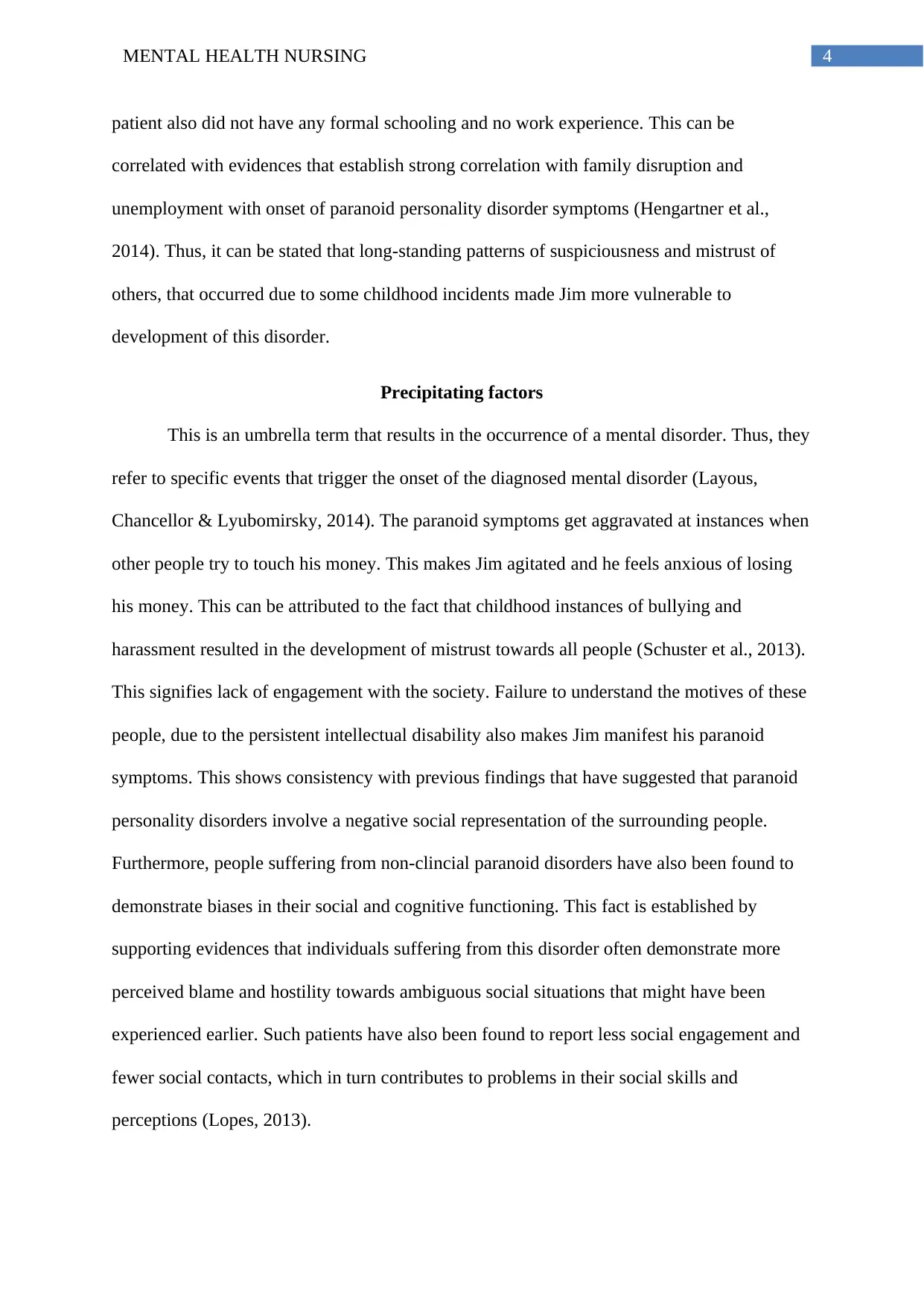
4MENTAL HEALTH NURSING
patient also did not have any formal schooling and no work experience. This can be
correlated with evidences that establish strong correlation with family disruption and
unemployment with onset of paranoid personality disorder symptoms (Hengartner et al.,
2014). Thus, it can be stated that long-standing patterns of suspiciousness and mistrust of
others, that occurred due to some childhood incidents made Jim more vulnerable to
development of this disorder.
Precipitating factors
This is an umbrella term that results in the occurrence of a mental disorder. Thus, they
refer to specific events that trigger the onset of the diagnosed mental disorder (Layous,
Chancellor & Lyubomirsky, 2014). The paranoid symptoms get aggravated at instances when
other people try to touch his money. This makes Jim agitated and he feels anxious of losing
his money. This can be attributed to the fact that childhood instances of bullying and
harassment resulted in the development of mistrust towards all people (Schuster et al., 2013).
This signifies lack of engagement with the society. Failure to understand the motives of these
people, due to the persistent intellectual disability also makes Jim manifest his paranoid
symptoms. This shows consistency with previous findings that have suggested that paranoid
personality disorders involve a negative social representation of the surrounding people.
Furthermore, people suffering from non-clincial paranoid disorders have also been found to
demonstrate biases in their social and cognitive functioning. This fact is established by
supporting evidences that individuals suffering from this disorder often demonstrate more
perceived blame and hostility towards ambiguous social situations that might have been
experienced earlier. Such patients have also been found to report less social engagement and
fewer social contacts, which in turn contributes to problems in their social skills and
perceptions (Lopes, 2013).
patient also did not have any formal schooling and no work experience. This can be
correlated with evidences that establish strong correlation with family disruption and
unemployment with onset of paranoid personality disorder symptoms (Hengartner et al.,
2014). Thus, it can be stated that long-standing patterns of suspiciousness and mistrust of
others, that occurred due to some childhood incidents made Jim more vulnerable to
development of this disorder.
Precipitating factors
This is an umbrella term that results in the occurrence of a mental disorder. Thus, they
refer to specific events that trigger the onset of the diagnosed mental disorder (Layous,
Chancellor & Lyubomirsky, 2014). The paranoid symptoms get aggravated at instances when
other people try to touch his money. This makes Jim agitated and he feels anxious of losing
his money. This can be attributed to the fact that childhood instances of bullying and
harassment resulted in the development of mistrust towards all people (Schuster et al., 2013).
This signifies lack of engagement with the society. Failure to understand the motives of these
people, due to the persistent intellectual disability also makes Jim manifest his paranoid
symptoms. This shows consistency with previous findings that have suggested that paranoid
personality disorders involve a negative social representation of the surrounding people.
Furthermore, people suffering from non-clincial paranoid disorders have also been found to
demonstrate biases in their social and cognitive functioning. This fact is established by
supporting evidences that individuals suffering from this disorder often demonstrate more
perceived blame and hostility towards ambiguous social situations that might have been
experienced earlier. Such patients have also been found to report less social engagement and
fewer social contacts, which in turn contributes to problems in their social skills and
perceptions (Lopes, 2013).
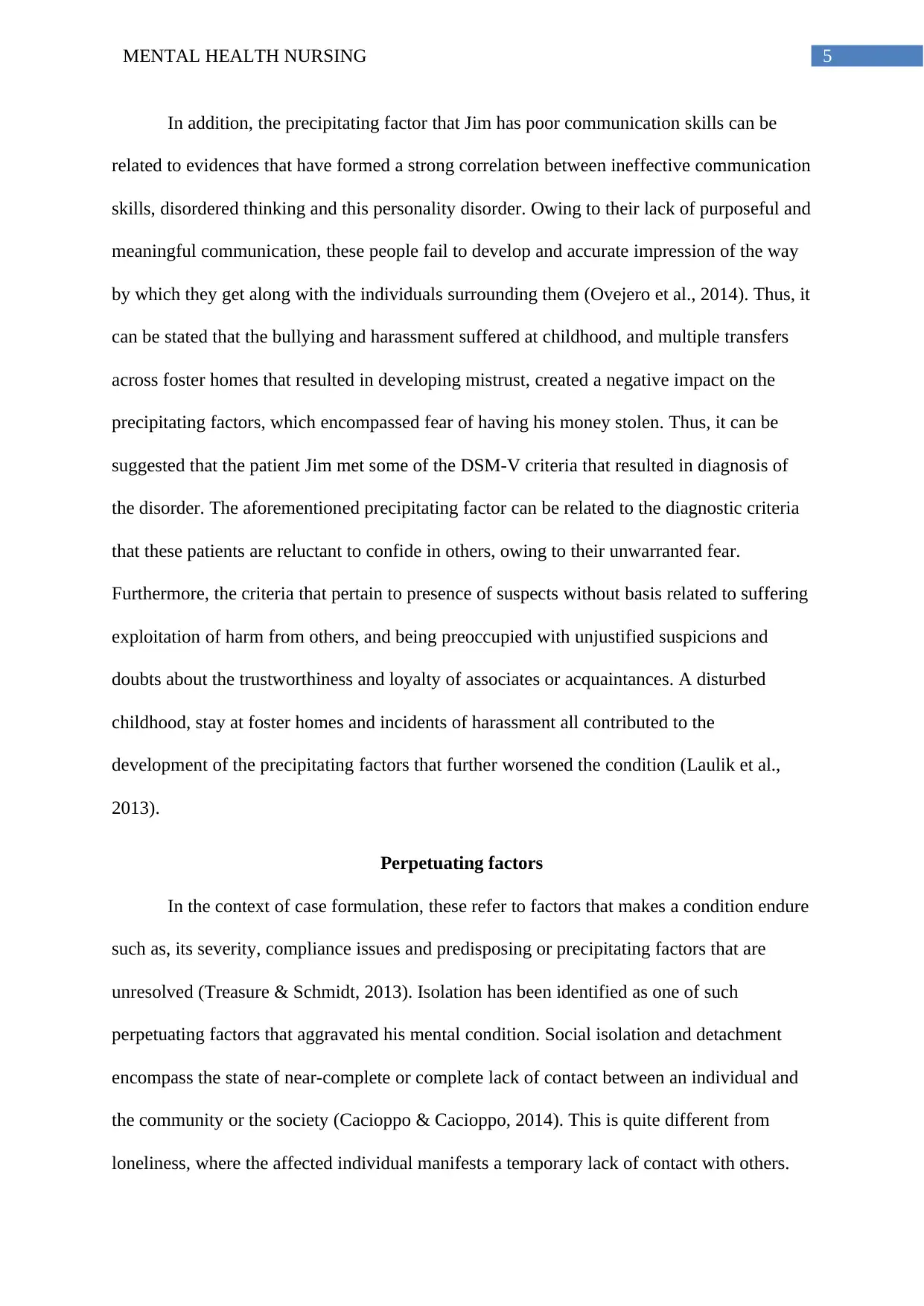
5MENTAL HEALTH NURSING
In addition, the precipitating factor that Jim has poor communication skills can be
related to evidences that have formed a strong correlation between ineffective communication
skills, disordered thinking and this personality disorder. Owing to their lack of purposeful and
meaningful communication, these people fail to develop and accurate impression of the way
by which they get along with the individuals surrounding them (Ovejero et al., 2014). Thus, it
can be stated that the bullying and harassment suffered at childhood, and multiple transfers
across foster homes that resulted in developing mistrust, created a negative impact on the
precipitating factors, which encompassed fear of having his money stolen. Thus, it can be
suggested that the patient Jim met some of the DSM-V criteria that resulted in diagnosis of
the disorder. The aforementioned precipitating factor can be related to the diagnostic criteria
that these patients are reluctant to confide in others, owing to their unwarranted fear.
Furthermore, the criteria that pertain to presence of suspects without basis related to suffering
exploitation of harm from others, and being preoccupied with unjustified suspicions and
doubts about the trustworthiness and loyalty of associates or acquaintances. A disturbed
childhood, stay at foster homes and incidents of harassment all contributed to the
development of the precipitating factors that further worsened the condition (Laulik et al.,
2013).
Perpetuating factors
In the context of case formulation, these refer to factors that makes a condition endure
such as, its severity, compliance issues and predisposing or precipitating factors that are
unresolved (Treasure & Schmidt, 2013). Isolation has been identified as one of such
perpetuating factors that aggravated his mental condition. Social isolation and detachment
encompass the state of near-complete or complete lack of contact between an individual and
the community or the society (Cacioppo & Cacioppo, 2014). This is quite different from
loneliness, where the affected individual manifests a temporary lack of contact with others.
In addition, the precipitating factor that Jim has poor communication skills can be
related to evidences that have formed a strong correlation between ineffective communication
skills, disordered thinking and this personality disorder. Owing to their lack of purposeful and
meaningful communication, these people fail to develop and accurate impression of the way
by which they get along with the individuals surrounding them (Ovejero et al., 2014). Thus, it
can be stated that the bullying and harassment suffered at childhood, and multiple transfers
across foster homes that resulted in developing mistrust, created a negative impact on the
precipitating factors, which encompassed fear of having his money stolen. Thus, it can be
suggested that the patient Jim met some of the DSM-V criteria that resulted in diagnosis of
the disorder. The aforementioned precipitating factor can be related to the diagnostic criteria
that these patients are reluctant to confide in others, owing to their unwarranted fear.
Furthermore, the criteria that pertain to presence of suspects without basis related to suffering
exploitation of harm from others, and being preoccupied with unjustified suspicions and
doubts about the trustworthiness and loyalty of associates or acquaintances. A disturbed
childhood, stay at foster homes and incidents of harassment all contributed to the
development of the precipitating factors that further worsened the condition (Laulik et al.,
2013).
Perpetuating factors
In the context of case formulation, these refer to factors that makes a condition endure
such as, its severity, compliance issues and predisposing or precipitating factors that are
unresolved (Treasure & Schmidt, 2013). Isolation has been identified as one of such
perpetuating factors that aggravated his mental condition. Social isolation and detachment
encompass the state of near-complete or complete lack of contact between an individual and
the community or the society (Cacioppo & Cacioppo, 2014). This is quite different from
loneliness, where the affected individual manifests a temporary lack of contact with others.
⊘ This is a preview!⊘
Do you want full access?
Subscribe today to unlock all pages.

Trusted by 1+ million students worldwide
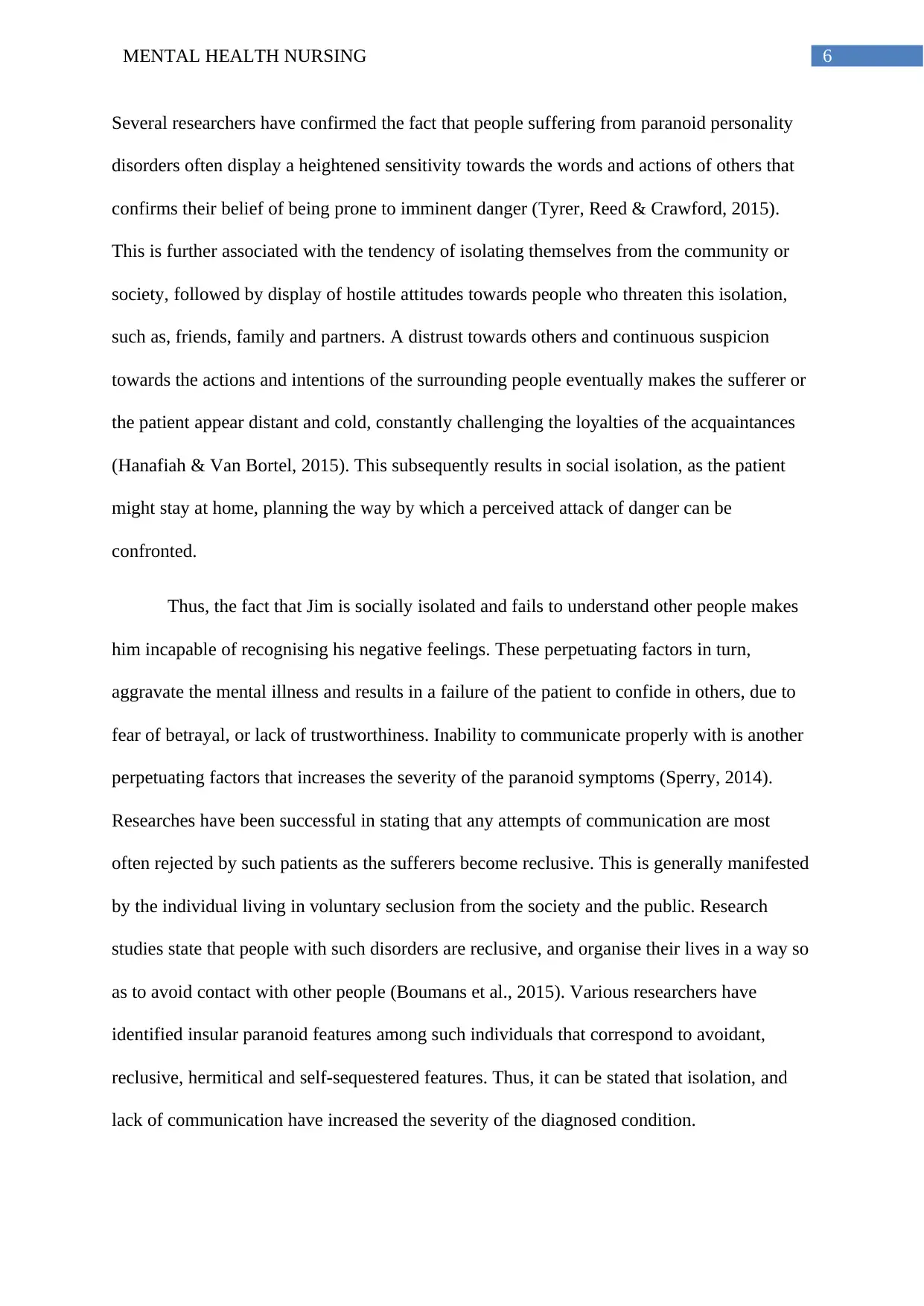
6MENTAL HEALTH NURSING
Several researchers have confirmed the fact that people suffering from paranoid personality
disorders often display a heightened sensitivity towards the words and actions of others that
confirms their belief of being prone to imminent danger (Tyrer, Reed & Crawford, 2015).
This is further associated with the tendency of isolating themselves from the community or
society, followed by display of hostile attitudes towards people who threaten this isolation,
such as, friends, family and partners. A distrust towards others and continuous suspicion
towards the actions and intentions of the surrounding people eventually makes the sufferer or
the patient appear distant and cold, constantly challenging the loyalties of the acquaintances
(Hanafiah & Van Bortel, 2015). This subsequently results in social isolation, as the patient
might stay at home, planning the way by which a perceived attack of danger can be
confronted.
Thus, the fact that Jim is socially isolated and fails to understand other people makes
him incapable of recognising his negative feelings. These perpetuating factors in turn,
aggravate the mental illness and results in a failure of the patient to confide in others, due to
fear of betrayal, or lack of trustworthiness. Inability to communicate properly with is another
perpetuating factors that increases the severity of the paranoid symptoms (Sperry, 2014).
Researches have been successful in stating that any attempts of communication are most
often rejected by such patients as the sufferers become reclusive. This is generally manifested
by the individual living in voluntary seclusion from the society and the public. Research
studies state that people with such disorders are reclusive, and organise their lives in a way so
as to avoid contact with other people (Boumans et al., 2015). Various researchers have
identified insular paranoid features among such individuals that correspond to avoidant,
reclusive, hermitical and self-sequestered features. Thus, it can be stated that isolation, and
lack of communication have increased the severity of the diagnosed condition.
Several researchers have confirmed the fact that people suffering from paranoid personality
disorders often display a heightened sensitivity towards the words and actions of others that
confirms their belief of being prone to imminent danger (Tyrer, Reed & Crawford, 2015).
This is further associated with the tendency of isolating themselves from the community or
society, followed by display of hostile attitudes towards people who threaten this isolation,
such as, friends, family and partners. A distrust towards others and continuous suspicion
towards the actions and intentions of the surrounding people eventually makes the sufferer or
the patient appear distant and cold, constantly challenging the loyalties of the acquaintances
(Hanafiah & Van Bortel, 2015). This subsequently results in social isolation, as the patient
might stay at home, planning the way by which a perceived attack of danger can be
confronted.
Thus, the fact that Jim is socially isolated and fails to understand other people makes
him incapable of recognising his negative feelings. These perpetuating factors in turn,
aggravate the mental illness and results in a failure of the patient to confide in others, due to
fear of betrayal, or lack of trustworthiness. Inability to communicate properly with is another
perpetuating factors that increases the severity of the paranoid symptoms (Sperry, 2014).
Researches have been successful in stating that any attempts of communication are most
often rejected by such patients as the sufferers become reclusive. This is generally manifested
by the individual living in voluntary seclusion from the society and the public. Research
studies state that people with such disorders are reclusive, and organise their lives in a way so
as to avoid contact with other people (Boumans et al., 2015). Various researchers have
identified insular paranoid features among such individuals that correspond to avoidant,
reclusive, hermitical and self-sequestered features. Thus, it can be stated that isolation, and
lack of communication have increased the severity of the diagnosed condition.
Paraphrase This Document
Need a fresh take? Get an instant paraphrase of this document with our AI Paraphraser
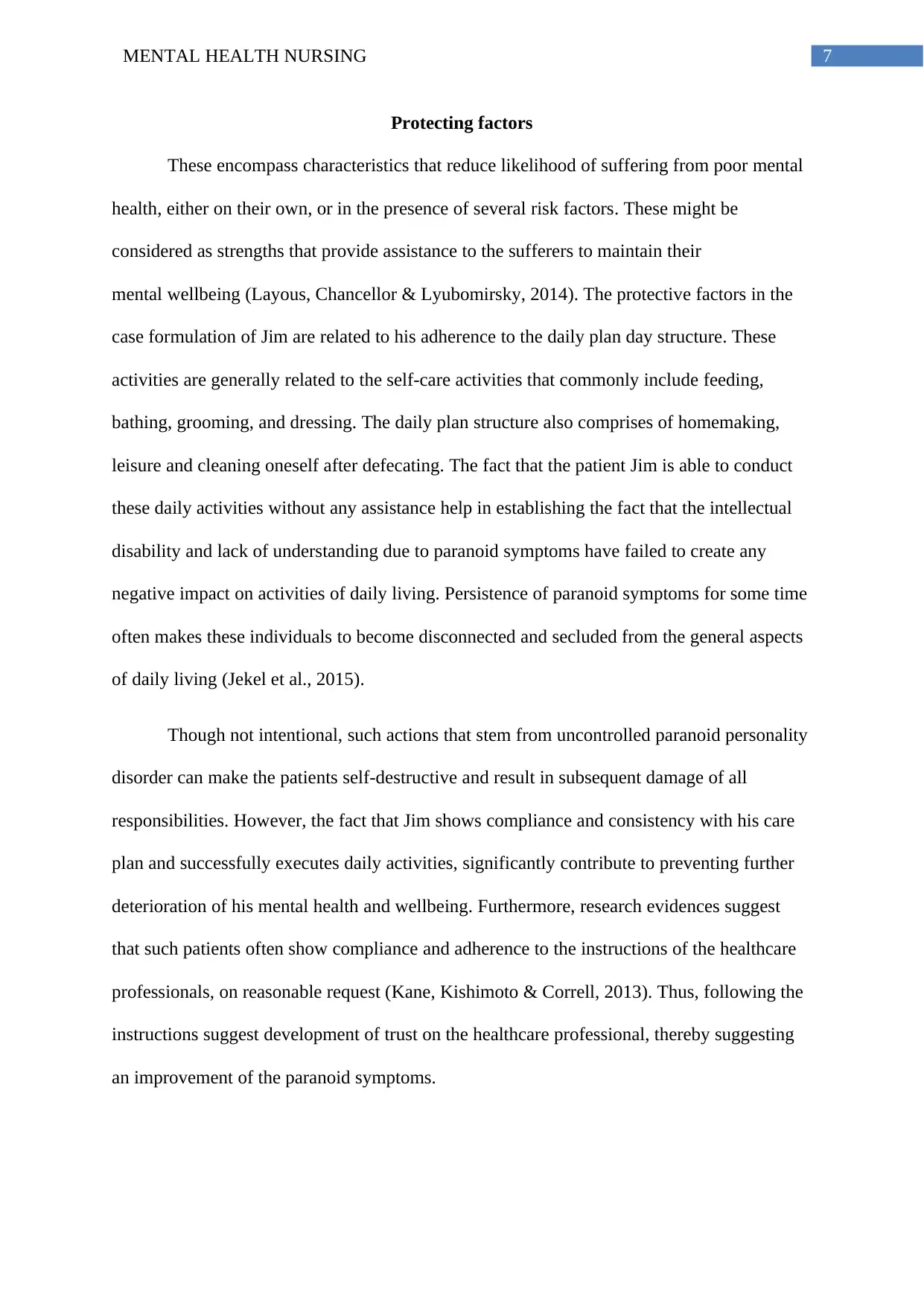
7MENTAL HEALTH NURSING
Protecting factors
These encompass characteristics that reduce likelihood of suffering from poor mental
health, either on their own, or in the presence of several risk factors. These might be
considered as strengths that provide assistance to the sufferers to maintain their
mental wellbeing (Layous, Chancellor & Lyubomirsky, 2014). The protective factors in the
case formulation of Jim are related to his adherence to the daily plan day structure. These
activities are generally related to the self-care activities that commonly include feeding,
bathing, grooming, and dressing. The daily plan structure also comprises of homemaking,
leisure and cleaning oneself after defecating. The fact that the patient Jim is able to conduct
these daily activities without any assistance help in establishing the fact that the intellectual
disability and lack of understanding due to paranoid symptoms have failed to create any
negative impact on activities of daily living. Persistence of paranoid symptoms for some time
often makes these individuals to become disconnected and secluded from the general aspects
of daily living (Jekel et al., 2015).
Though not intentional, such actions that stem from uncontrolled paranoid personality
disorder can make the patients self-destructive and result in subsequent damage of all
responsibilities. However, the fact that Jim shows compliance and consistency with his care
plan and successfully executes daily activities, significantly contribute to preventing further
deterioration of his mental health and wellbeing. Furthermore, research evidences suggest
that such patients often show compliance and adherence to the instructions of the healthcare
professionals, on reasonable request (Kane, Kishimoto & Correll, 2013). Thus, following the
instructions suggest development of trust on the healthcare professional, thereby suggesting
an improvement of the paranoid symptoms.
Protecting factors
These encompass characteristics that reduce likelihood of suffering from poor mental
health, either on their own, or in the presence of several risk factors. These might be
considered as strengths that provide assistance to the sufferers to maintain their
mental wellbeing (Layous, Chancellor & Lyubomirsky, 2014). The protective factors in the
case formulation of Jim are related to his adherence to the daily plan day structure. These
activities are generally related to the self-care activities that commonly include feeding,
bathing, grooming, and dressing. The daily plan structure also comprises of homemaking,
leisure and cleaning oneself after defecating. The fact that the patient Jim is able to conduct
these daily activities without any assistance help in establishing the fact that the intellectual
disability and lack of understanding due to paranoid symptoms have failed to create any
negative impact on activities of daily living. Persistence of paranoid symptoms for some time
often makes these individuals to become disconnected and secluded from the general aspects
of daily living (Jekel et al., 2015).
Though not intentional, such actions that stem from uncontrolled paranoid personality
disorder can make the patients self-destructive and result in subsequent damage of all
responsibilities. However, the fact that Jim shows compliance and consistency with his care
plan and successfully executes daily activities, significantly contribute to preventing further
deterioration of his mental health and wellbeing. Furthermore, research evidences suggest
that such patients often show compliance and adherence to the instructions of the healthcare
professionals, on reasonable request (Kane, Kishimoto & Correll, 2013). Thus, following the
instructions suggest development of trust on the healthcare professional, thereby suggesting
an improvement of the paranoid symptoms.
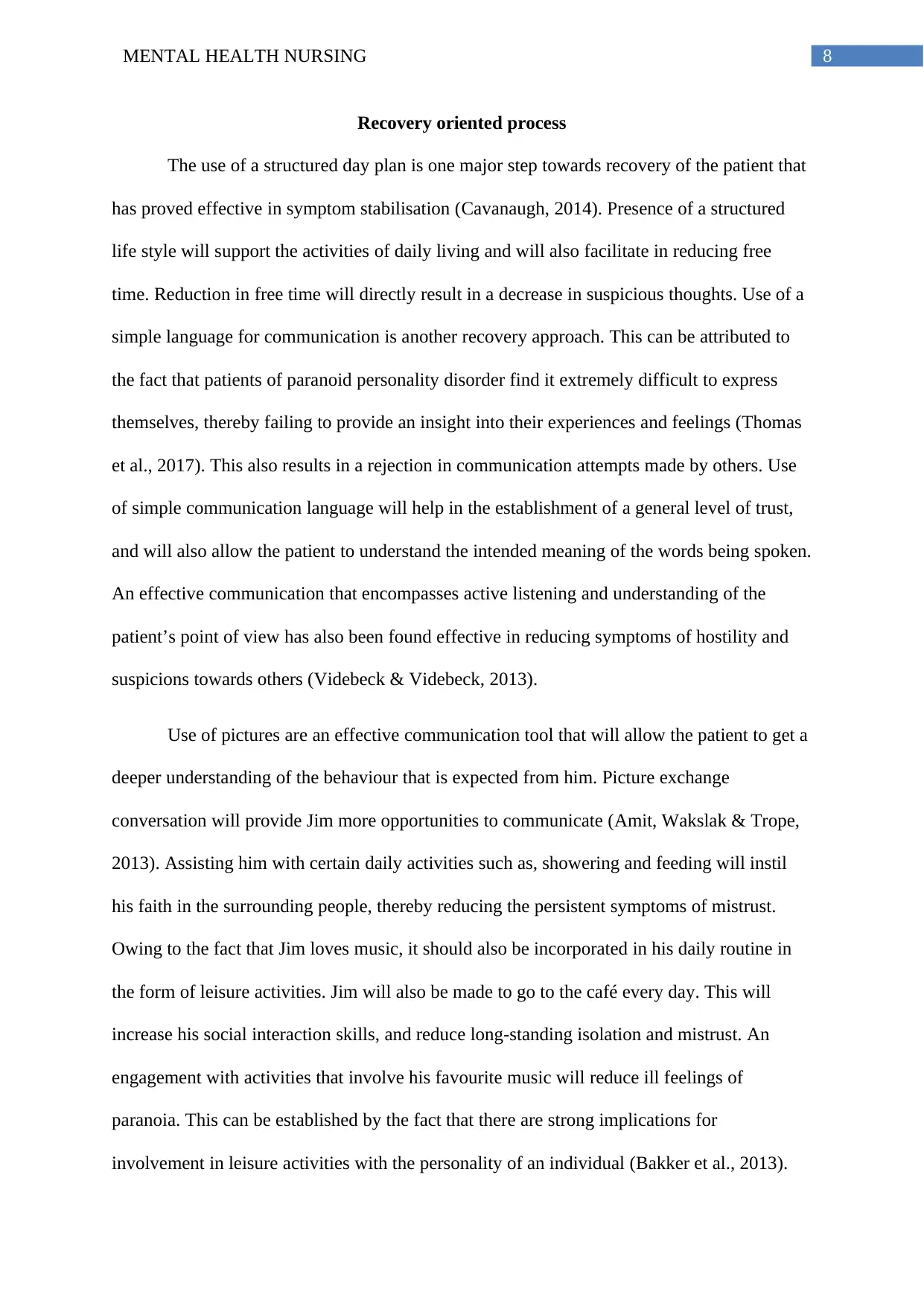
8MENTAL HEALTH NURSING
Recovery oriented process
The use of a structured day plan is one major step towards recovery of the patient that
has proved effective in symptom stabilisation (Cavanaugh, 2014). Presence of a structured
life style will support the activities of daily living and will also facilitate in reducing free
time. Reduction in free time will directly result in a decrease in suspicious thoughts. Use of a
simple language for communication is another recovery approach. This can be attributed to
the fact that patients of paranoid personality disorder find it extremely difficult to express
themselves, thereby failing to provide an insight into their experiences and feelings (Thomas
et al., 2017). This also results in a rejection in communication attempts made by others. Use
of simple communication language will help in the establishment of a general level of trust,
and will also allow the patient to understand the intended meaning of the words being spoken.
An effective communication that encompasses active listening and understanding of the
patient’s point of view has also been found effective in reducing symptoms of hostility and
suspicions towards others (Videbeck & Videbeck, 2013).
Use of pictures are an effective communication tool that will allow the patient to get a
deeper understanding of the behaviour that is expected from him. Picture exchange
conversation will provide Jim more opportunities to communicate (Amit, Wakslak & Trope,
2013). Assisting him with certain daily activities such as, showering and feeding will instil
his faith in the surrounding people, thereby reducing the persistent symptoms of mistrust.
Owing to the fact that Jim loves music, it should also be incorporated in his daily routine in
the form of leisure activities. Jim will also be made to go to the café every day. This will
increase his social interaction skills, and reduce long-standing isolation and mistrust. An
engagement with activities that involve his favourite music will reduce ill feelings of
paranoia. This can be established by the fact that there are strong implications for
involvement in leisure activities with the personality of an individual (Bakker et al., 2013).
Recovery oriented process
The use of a structured day plan is one major step towards recovery of the patient that
has proved effective in symptom stabilisation (Cavanaugh, 2014). Presence of a structured
life style will support the activities of daily living and will also facilitate in reducing free
time. Reduction in free time will directly result in a decrease in suspicious thoughts. Use of a
simple language for communication is another recovery approach. This can be attributed to
the fact that patients of paranoid personality disorder find it extremely difficult to express
themselves, thereby failing to provide an insight into their experiences and feelings (Thomas
et al., 2017). This also results in a rejection in communication attempts made by others. Use
of simple communication language will help in the establishment of a general level of trust,
and will also allow the patient to understand the intended meaning of the words being spoken.
An effective communication that encompasses active listening and understanding of the
patient’s point of view has also been found effective in reducing symptoms of hostility and
suspicions towards others (Videbeck & Videbeck, 2013).
Use of pictures are an effective communication tool that will allow the patient to get a
deeper understanding of the behaviour that is expected from him. Picture exchange
conversation will provide Jim more opportunities to communicate (Amit, Wakslak & Trope,
2013). Assisting him with certain daily activities such as, showering and feeding will instil
his faith in the surrounding people, thereby reducing the persistent symptoms of mistrust.
Owing to the fact that Jim loves music, it should also be incorporated in his daily routine in
the form of leisure activities. Jim will also be made to go to the café every day. This will
increase his social interaction skills, and reduce long-standing isolation and mistrust. An
engagement with activities that involve his favourite music will reduce ill feelings of
paranoia. This can be established by the fact that there are strong implications for
involvement in leisure activities with the personality of an individual (Bakker et al., 2013).
⊘ This is a preview!⊘
Do you want full access?
Subscribe today to unlock all pages.

Trusted by 1+ million students worldwide
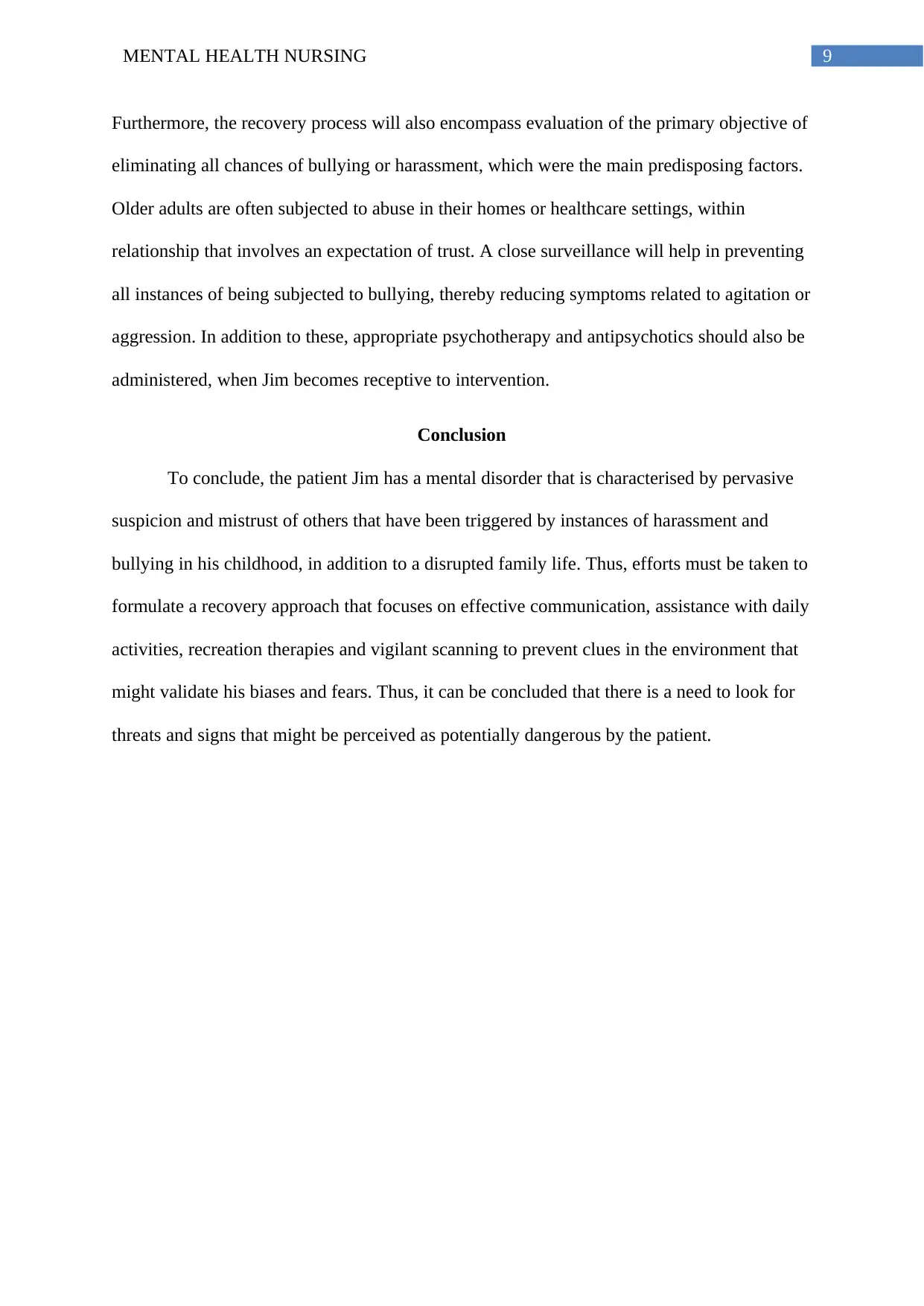
9MENTAL HEALTH NURSING
Furthermore, the recovery process will also encompass evaluation of the primary objective of
eliminating all chances of bullying or harassment, which were the main predisposing factors.
Older adults are often subjected to abuse in their homes or healthcare settings, within
relationship that involves an expectation of trust. A close surveillance will help in preventing
all instances of being subjected to bullying, thereby reducing symptoms related to agitation or
aggression. In addition to these, appropriate psychotherapy and antipsychotics should also be
administered, when Jim becomes receptive to intervention.
Conclusion
To conclude, the patient Jim has a mental disorder that is characterised by pervasive
suspicion and mistrust of others that have been triggered by instances of harassment and
bullying in his childhood, in addition to a disrupted family life. Thus, efforts must be taken to
formulate a recovery approach that focuses on effective communication, assistance with daily
activities, recreation therapies and vigilant scanning to prevent clues in the environment that
might validate his biases and fears. Thus, it can be concluded that there is a need to look for
threats and signs that might be perceived as potentially dangerous by the patient.
Furthermore, the recovery process will also encompass evaluation of the primary objective of
eliminating all chances of bullying or harassment, which were the main predisposing factors.
Older adults are often subjected to abuse in their homes or healthcare settings, within
relationship that involves an expectation of trust. A close surveillance will help in preventing
all instances of being subjected to bullying, thereby reducing symptoms related to agitation or
aggression. In addition to these, appropriate psychotherapy and antipsychotics should also be
administered, when Jim becomes receptive to intervention.
Conclusion
To conclude, the patient Jim has a mental disorder that is characterised by pervasive
suspicion and mistrust of others that have been triggered by instances of harassment and
bullying in his childhood, in addition to a disrupted family life. Thus, efforts must be taken to
formulate a recovery approach that focuses on effective communication, assistance with daily
activities, recreation therapies and vigilant scanning to prevent clues in the environment that
might validate his biases and fears. Thus, it can be concluded that there is a need to look for
threats and signs that might be perceived as potentially dangerous by the patient.
Paraphrase This Document
Need a fresh take? Get an instant paraphrase of this document with our AI Paraphraser
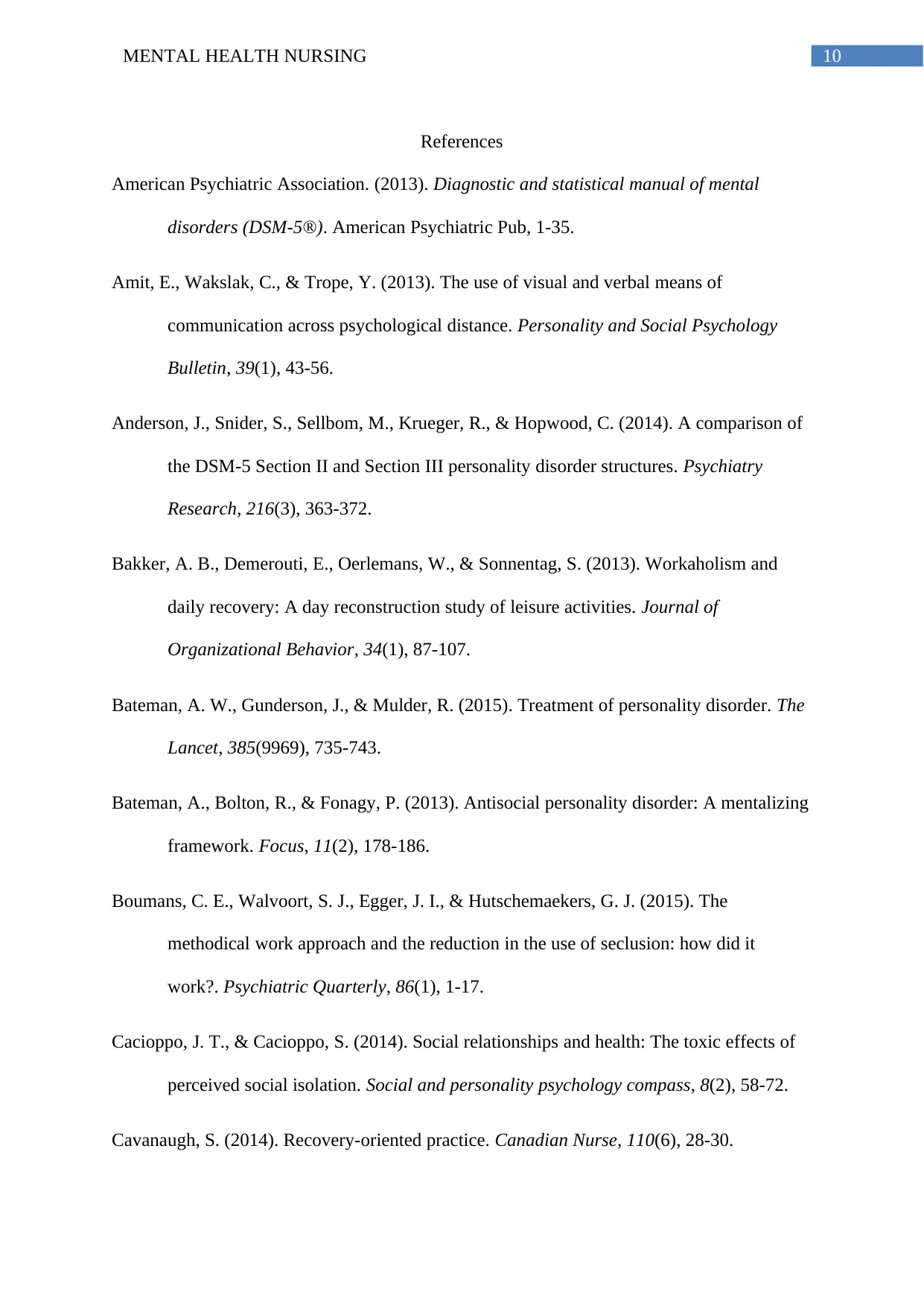
10MENTAL HEALTH NURSING
References
American Psychiatric Association. (2013). Diagnostic and statistical manual of mental
disorders (DSM-5®). American Psychiatric Pub, 1-35.
Amit, E., Wakslak, C., & Trope, Y. (2013). The use of visual and verbal means of
communication across psychological distance. Personality and Social Psychology
Bulletin, 39(1), 43-56.
Anderson, J., Snider, S., Sellbom, M., Krueger, R., & Hopwood, C. (2014). A comparison of
the DSM-5 Section II and Section III personality disorder structures. Psychiatry
Research, 216(3), 363-372.
Bakker, A. B., Demerouti, E., Oerlemans, W., & Sonnentag, S. (2013). Workaholism and
daily recovery: A day reconstruction study of leisure activities. Journal of
Organizational Behavior, 34(1), 87-107.
Bateman, A. W., Gunderson, J., & Mulder, R. (2015). Treatment of personality disorder. The
Lancet, 385(9969), 735-743.
Bateman, A., Bolton, R., & Fonagy, P. (2013). Antisocial personality disorder: A mentalizing
framework. Focus, 11(2), 178-186.
Boumans, C. E., Walvoort, S. J., Egger, J. I., & Hutschemaekers, G. J. (2015). The
methodical work approach and the reduction in the use of seclusion: how did it
work?. Psychiatric Quarterly, 86(1), 1-17.
Cacioppo, J. T., & Cacioppo, S. (2014). Social relationships and health: The toxic effects of
perceived social isolation. Social and personality psychology compass, 8(2), 58-72.
Cavanaugh, S. (2014). Recovery-oriented practice. Canadian Nurse, 110(6), 28-30.
References
American Psychiatric Association. (2013). Diagnostic and statistical manual of mental
disorders (DSM-5®). American Psychiatric Pub, 1-35.
Amit, E., Wakslak, C., & Trope, Y. (2013). The use of visual and verbal means of
communication across psychological distance. Personality and Social Psychology
Bulletin, 39(1), 43-56.
Anderson, J., Snider, S., Sellbom, M., Krueger, R., & Hopwood, C. (2014). A comparison of
the DSM-5 Section II and Section III personality disorder structures. Psychiatry
Research, 216(3), 363-372.
Bakker, A. B., Demerouti, E., Oerlemans, W., & Sonnentag, S. (2013). Workaholism and
daily recovery: A day reconstruction study of leisure activities. Journal of
Organizational Behavior, 34(1), 87-107.
Bateman, A. W., Gunderson, J., & Mulder, R. (2015). Treatment of personality disorder. The
Lancet, 385(9969), 735-743.
Bateman, A., Bolton, R., & Fonagy, P. (2013). Antisocial personality disorder: A mentalizing
framework. Focus, 11(2), 178-186.
Boumans, C. E., Walvoort, S. J., Egger, J. I., & Hutschemaekers, G. J. (2015). The
methodical work approach and the reduction in the use of seclusion: how did it
work?. Psychiatric Quarterly, 86(1), 1-17.
Cacioppo, J. T., & Cacioppo, S. (2014). Social relationships and health: The toxic effects of
perceived social isolation. Social and personality psychology compass, 8(2), 58-72.
Cavanaugh, S. (2014). Recovery-oriented practice. Canadian Nurse, 110(6), 28-30.
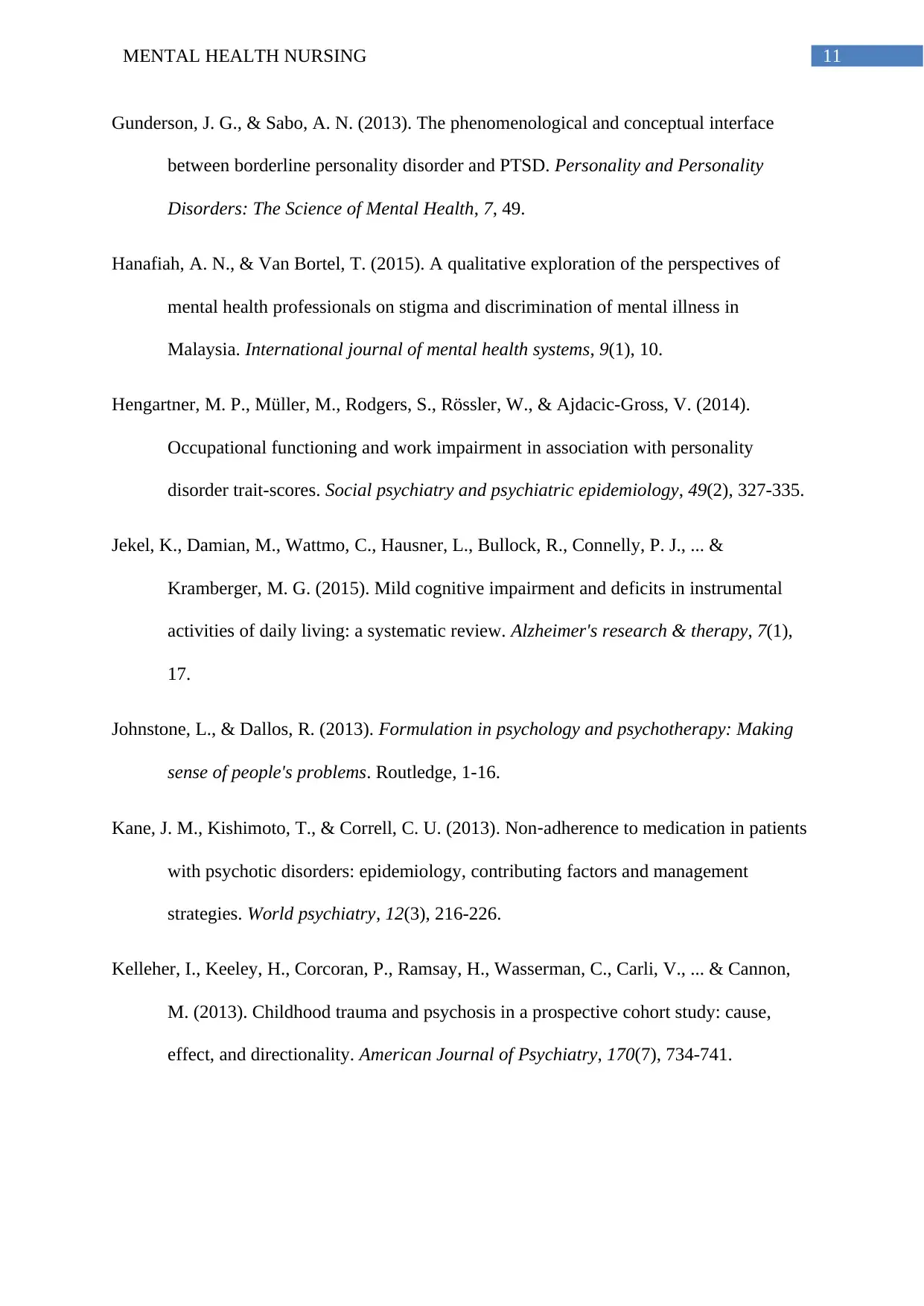
11MENTAL HEALTH NURSING
Gunderson, J. G., & Sabo, A. N. (2013). The phenomenological and conceptual interface
between borderline personality disorder and PTSD. Personality and Personality
Disorders: The Science of Mental Health, 7, 49.
Hanafiah, A. N., & Van Bortel, T. (2015). A qualitative exploration of the perspectives of
mental health professionals on stigma and discrimination of mental illness in
Malaysia. International journal of mental health systems, 9(1), 10.
Hengartner, M. P., Müller, M., Rodgers, S., Rössler, W., & Ajdacic-Gross, V. (2014).
Occupational functioning and work impairment in association with personality
disorder trait-scores. Social psychiatry and psychiatric epidemiology, 49(2), 327-335.
Jekel, K., Damian, M., Wattmo, C., Hausner, L., Bullock, R., Connelly, P. J., ... &
Kramberger, M. G. (2015). Mild cognitive impairment and deficits in instrumental
activities of daily living: a systematic review. Alzheimer's research & therapy, 7(1),
17.
Johnstone, L., & Dallos, R. (2013). Formulation in psychology and psychotherapy: Making
sense of people's problems. Routledge, 1-16.
Kane, J. M., Kishimoto, T., & Correll, C. U. (2013). Non‐adherence to medication in patients
with psychotic disorders: epidemiology, contributing factors and management
strategies. World psychiatry, 12(3), 216-226.
Kelleher, I., Keeley, H., Corcoran, P., Ramsay, H., Wasserman, C., Carli, V., ... & Cannon,
M. (2013). Childhood trauma and psychosis in a prospective cohort study: cause,
effect, and directionality. American Journal of Psychiatry, 170(7), 734-741.
Gunderson, J. G., & Sabo, A. N. (2013). The phenomenological and conceptual interface
between borderline personality disorder and PTSD. Personality and Personality
Disorders: The Science of Mental Health, 7, 49.
Hanafiah, A. N., & Van Bortel, T. (2015). A qualitative exploration of the perspectives of
mental health professionals on stigma and discrimination of mental illness in
Malaysia. International journal of mental health systems, 9(1), 10.
Hengartner, M. P., Müller, M., Rodgers, S., Rössler, W., & Ajdacic-Gross, V. (2014).
Occupational functioning and work impairment in association with personality
disorder trait-scores. Social psychiatry and psychiatric epidemiology, 49(2), 327-335.
Jekel, K., Damian, M., Wattmo, C., Hausner, L., Bullock, R., Connelly, P. J., ... &
Kramberger, M. G. (2015). Mild cognitive impairment and deficits in instrumental
activities of daily living: a systematic review. Alzheimer's research & therapy, 7(1),
17.
Johnstone, L., & Dallos, R. (2013). Formulation in psychology and psychotherapy: Making
sense of people's problems. Routledge, 1-16.
Kane, J. M., Kishimoto, T., & Correll, C. U. (2013). Non‐adherence to medication in patients
with psychotic disorders: epidemiology, contributing factors and management
strategies. World psychiatry, 12(3), 216-226.
Kelleher, I., Keeley, H., Corcoran, P., Ramsay, H., Wasserman, C., Carli, V., ... & Cannon,
M. (2013). Childhood trauma and psychosis in a prospective cohort study: cause,
effect, and directionality. American Journal of Psychiatry, 170(7), 734-741.
⊘ This is a preview!⊘
Do you want full access?
Subscribe today to unlock all pages.

Trusted by 1+ million students worldwide
1 out of 15
Related Documents
Your All-in-One AI-Powered Toolkit for Academic Success.
+13062052269
info@desklib.com
Available 24*7 on WhatsApp / Email
![[object Object]](/_next/static/media/star-bottom.7253800d.svg)
Unlock your academic potential
Copyright © 2020–2025 A2Z Services. All Rights Reserved. Developed and managed by ZUCOL.





